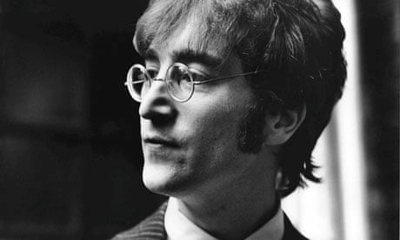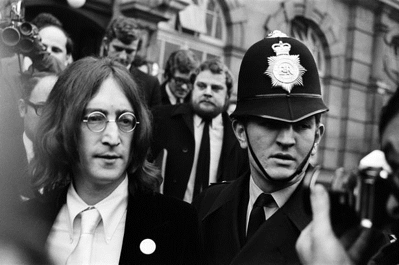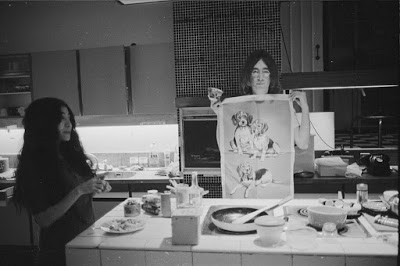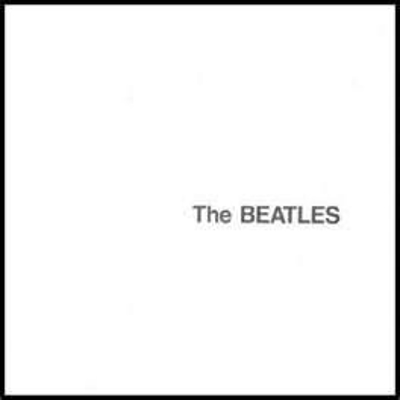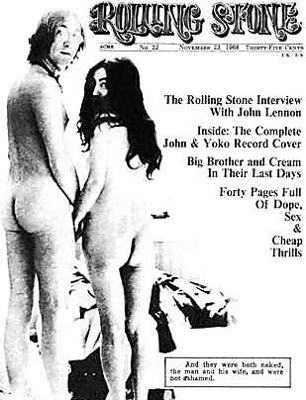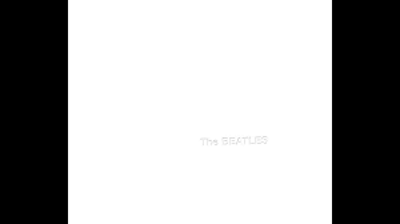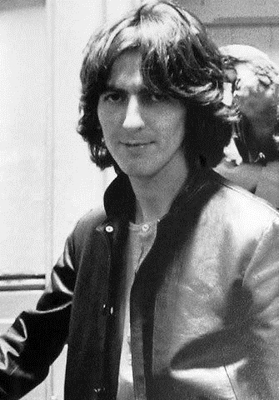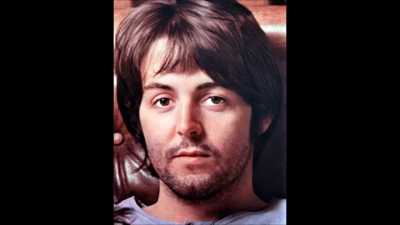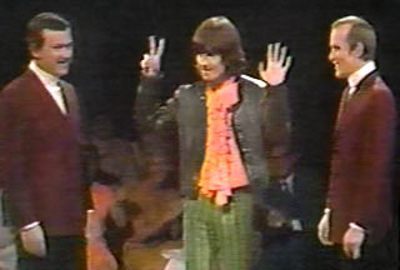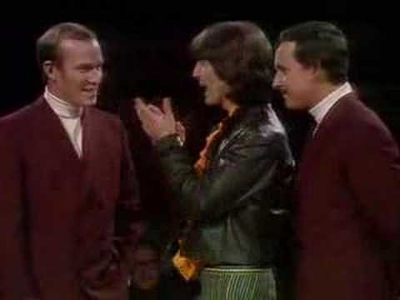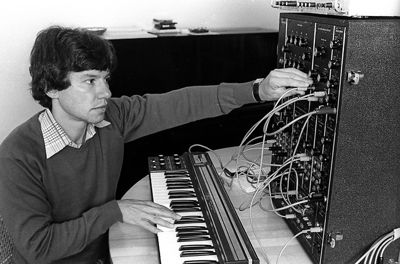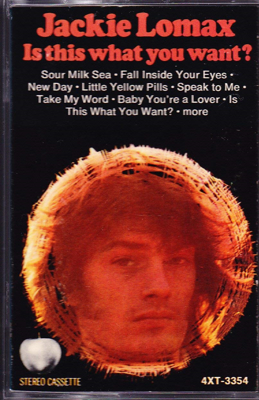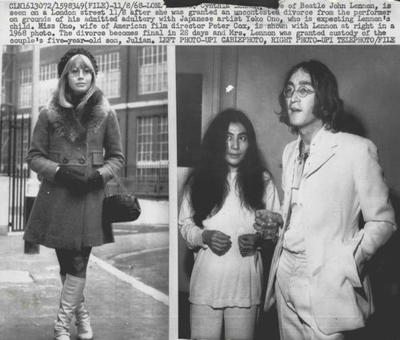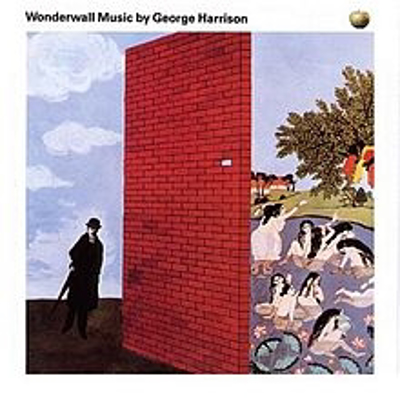The Beatles taking a break this last day of the month.
1968, November
Originally published in the Guardian on 29 November 1968
John Lennon, one of the Beatles, was fined £150 with 20 guineas costs at Marylebone Court in London yesterday after admitting possessing the drug cannabis. A charge against him of obstructing police in the execution of a search warrant, to which he pleaded not guilty, was dismissed after the prosecution had offered no evidence on this.
Mrs Yoko Ono Cox (34), a friend, who was with Lennon in the dock, was cleared of both charges against her – possessing cannabis and obstructing police – after the prosecution had offered no evidence against her. She had denied both charges.
Drugs in flat
Mr Roger Frisby, prosecuting, said the pleas were acceptable to the prosecution. As far as the charge of possessing cannabis was concerned, they were found in a flat which was in their joint occupation. "When the drugs were found Lennon took full responsibility himself and by implication said Mrs Cox had nothing to do with it. There is not evidence that she did and in the circumstances I think it right to accept the plea."
As far as the charge of obstructing the police was concerned, there was an obstruction or delay of seven or eight minutes before the officer was admitted to the flat. There was no suggestion that either defendant took advantage of the time to dispose of the drugs and he felt the plea was a proper one to accept.
Mr Martin Polden, defending, said that Lennon and Mrs Cox had occupied the flat for about three months before the police searched it. They had moved there following Mr Lennon's "marital" difficulties.
It was a "highly emotional situation" for Lennon and Mrs Cox. She had been in hospital for about two weeks, hoping that her baby could be saved, but it was not. They were looking forward to having a child. Mr Polden said of Lennon: "He is an artist of note and integrity. He has brought some pleasure to millions. He has stood by his views. He is entitled to some compassion of the court."
The magistrate: "Can I take it that John Lennon is a man of considerable substance ?"
Mr Polden: "He is a man of considerable substance."
The magistrate told Lennon: "I have come to the conclusion that it is not possible to deal with this matter by way of conditional discharge. There must be a financial penalty."
[John Lennon's divorce from his first wife Cynthia was granted on 8 November 1968. He married Yoko Ono in 1969.]
John Lennon appeared at Marylebone Magistrates' Court, London for cannabis possession.
John pled guilty, because he was worried Yoko Ono may be deported from the United Kingdom.
During the hearing Lennon's solicitor, Martin Polden, told the court that Ono had recently lost their baby, which had been a terrible blow to the couple. Additionally, Polden declared that Lennon had renounced drugs after becoming a devotee of Maharishi Mahesh Yogi the previous year, and stressed that the Beatle had "given pleasure to millions" through his music.
The magistrate quashed the charge of obstruction to justice, and fined Lennon £150 plus court costs of 20 guineas. Lennon was also warned that if he was found guilty again of a similar offence he risked a custodial sentence.
It was better when it happened. It's been building up for years – thinking something would happen. Now, the fear has gone a bit. Now you know what it's like, it's a bit different. And it's not too bad; a £150 fine.
Although the judge exercised some leniency, the repercussions of the case continued for Lennon for many years. The conviction was a key factor in the Nixon administration's efforts to deny Lennon a Green Card for residence in the US.
Hey Jude - Still Number One!
Kenwood: November 26th, 1968.
Music-versary: The Beatles’ ‘White Album’ was released November 25, 1968
Credits: John Lennon (Guitar, vocals); Paul McCartney (Bass, vocals); George Harrison (Guitar, vocals); Ringo Starr (Drums, vocals)
Backstory: Better known as the White Album for its stark, simple cover art, the Beatle’s double, self-titled LP can be seen as the musical peak for the band that helped define the 1960s—but also the beginning of the end for them.
In February 1968, the band took a trip India to the Maharishi Mahesh Yogi’s Transcendental Meditation Retreat, along with some famous friends like Donovan, Mike Love, and Mia Farrow. There, they were able to all spend time reconnecting with themselves and their art, each writing numerous songs in the process. George, in particular, was coming into his own, though as musicologist Walter Everett later noted, he was quiet about this fact, and was “privately prolific.”
There was more than just a musical disconnect, though. John had taken up with avant-garde artist Yoko Ono, and John’s reverence for her opinions, along with her new presence in the studio (and John’s burgeoning heroin addiction) drove a wedge between him and his erstwhile closest partners. George was quickly finding himself, jamming with his good friend, Cream guitarist Eric Clapton. Paul was trying to keep the band together—even writing Hey Jude for Lennon’s son, Julian—and Ringo was so fed up with the outfit that he quit for a few days. But the final album was, if disjointed, a masterpiece, running the gamut from rock and roll (Back in the U.S.S.R) to folk (Blackbird) to guitar spiritual (While My Guitar Gently Weeps) to a kind of distorted screech (Revolution 9) that predicted the metal days to come. As Lester Bangs would later put it, the result of the sessions would be “the first album by The Beatles or in the history of rock by four solo artist in one band.”
Rumors: In 1967, a rumor began going around that Paul McCarney had been killed in 1966 and the band, desperate to keep their group together but equally eager to share their terrible secret with the world, was putting clues in their artwork and music so their fans might share in their grief. While the cover offers no clues—a clear change from their previous album, Sergeant Pepper’s Lonely Hearts Club Band, which offered plenty of fodder—there are lyrics which let on the boys might have been in on the joke. Referring to the cover of Magical Mystery Tour, on which one of the members was dressed as a walrus—supposedly a symbol of death—John sang on the song Glass Onion, “I told you ‘bout the walrus and me, man / You know that we’re as close as can be, man / well here’s another clue for you all / the walrus was Paul.”
Parting Ways: Another longtime collaborator, producer and “fifth Beatle” George Martin, walked off the job on this album. Later, he claimed that he wasn’t fully happy with the product. “I thought we should probably have made a very, very good single album rather than a double,” he said. “But they insisted. I think it could have been made fantastically good if it had been compressed a bit and condensed. A lot of people I know think it’s still the best album they made.”
Hey Jude - Still Number One!
The interview took place at John Lennon and Yoko Ono’s temporary basement flat in London -- a flat where Jimi Hendrix, Ringo Starr and William Burroughs, among others, have stayed. But the flat seemed as much John and Yoko’s as the Indian incense that took over the living room. The walls were covered with photos of John, of Yoko, a giant Sgt. Pepper ensign, Richard Chamberlain’s poster collage of news clippings of the Stones bust, the Time magazine cover of the Beatles.
We arrived at five on the afternoon of September 17, said hello to gallery owner Robert Fraser, who had arranged the interview, and to John and Yoko, sitting together, looking “tres bien ensemble”. We sat down around a simple wooden table covered with magazines, newspapers, sketch paper, boxes, drawings, a beaded necklace shaped in the form of a pentangle.
John said he had to be at a recording session in half an hour, so we talked for a while about John’s show at the Fraser Gallery. John wrote some reminders to himself in the wonderfully intense absorbed way that a kid has painting the sun for the first time. As a philosopher once remarked: "Were art to redeem man, it could do so only by saving him from the seriousness of life and restoring him to an unexpected boyishness." When we arrived the next afternoon, September 18, John was walking around the room, humming what sounded like “Hold Me Tight” -- just singing the song to the air. Old '50's forty-fives were scattered about the floor, and John played Rosie and the Originals’ version of “Give Me Love.” We talked about the lyrics of Gene Vincent’s “Woman Love.” In spite of having slept only two hours, John asked us to sit down on the floor and begin the interview.
If there’s one word to describe The Beatles’ ninth studio album, it’s “chaos.”
There was so much going on in the worlds of John, Paul George and Ringo. For starters, the band was coming off the massive success of Sgt. Pepper’s Lonely Hearts Club Band. They then founded Apple Corps Ltd., which drained a bunch of money. The Beatles then got all up in Transcendental Meditation and spent some time in India, where they wrote most of the album.
Oh…and the recording of “The While Album” was the time when John Lennon first starting seeing Yoko Ono, who was often present at Abbey Road Studios, which was odd considering The Beatles up until that point worked alone.
While the 30-track double album brought forth an incredibly diverse set of music, it was a sign that it was the beginning of the end. Each Beatle worked on their own songs separately and only worked with their band mates when necessary. Despite this divide and tension, The Beatles still managed to deliver one of the most bold albums in the history of rock.
Today George Harrison was in a recording session for the British band Cream to record the song Badge. It took place at Wally Heider Studios in Los Angeles. Badge was written by Harrison and Eric Clapton.
Badge was produced by Felix Pappalardi, who had worked with Cream since their Disraeli Gears album and the song was credited to Clapton and Harrison on the UK single.
Harrison performs rhythm guitar on Badge and Clapton plays midway through the song.
Guitar Player Interview, 1987:
Q: I always wondered about, speaking of collaboration, “Badge,” the bridge part where the guitarist played through the Leslie. Is that you?
GH: No, that’s where Eric enters. On the record Eric doesn’t play guitar up until that bridge. So there was Felix, Jack Bruce, Ginger Baker and me. I played the rhythm, the chops. And we played the song right up to the bridge, at which point Eric came in on the guitar on the Leslie. And then he overdubbed the solo part later.
Q: Did he write all the music?
GH: I wrote most of the words. Eric had that bridge, definitely. And he had a couple of chords I think. He called me up saying, “look, you know we’re doing this last album and we’ve all got to have our song by Monday,” or something. He came by and I think he had the first couple of chord changes, and then I joined in and finished the verses off. And then he had the middle bit already. I think I wrote most of the words to the song but he was there, and we bounced off of each other.
Stream: http://buff.ly/2eUiySI
After the completion of the White Album, The Beatles worked on their own projects or just took a break. With the group unable or unwilling to pull together to promote the album, Paul McCartney gave an interview on this day to Radio Luxembourg.
The interview took place at McCartney's home in London. Paul mmented only on songs he had written or sung on, with the exceptions of Happiness Is A Warm Gun and Good Night.
Tony Macurthur conducted the interview and expressed surprise that the album was not a progression from Sgt Pepper, to which McCartney explained "It's another step, but it's not necessarily in the way people expected." He also said the songs were easier to perform live, hinting at a return to the stage after two years away.
The show was first broadcast on November 20th, in a special two-hour show on the album. It also contained contributions, recorded separately, from Judith Simons, the Daily Express newspaper's pop correspondent.
Hey Jude - The Beatles
Hey Jude is Number One!
ABOUT THIS INTERVIEW:
In November 1968, George Harrison stopped by during a taping of the CBS-TV program 'The Smothers Brothers Comedy Hour,' for an impromptu cameo appearance. In this brief chat which would air on November 17th, George joked with Tommy and Dick about the on-going network censorship of their show.
In previous weeks, the Smothers Brothers had exclusive Amercian-TV rights for airing the promotional films for 'Hey Jude' and 'Revolution,' the Beatles latest no. 1 single.
Tommy Smothers would later remember: "Beatle George Harrison was on this show. He makes a surprise appearance and surprised everybody." Dick Smothers added: "Back then in that year, The Beatles were the biggest thing in the entire universe. And to have George Harrison just stop on by to wish us luck and say 'Go on, keep doing it,' it was a real coup."
The Smothers Brothers Comedy Hour was a cutting edge program featuring top-name musical guests and politcal satire. The program was often censored for politcal reasons which baffled Tom Smothers, who contractually had creative control over the scripts. The show would be cancelled in 1969 because of tensions with the network - tensions stemming from the fact that the show's political views did not agree with those of the CBS network president at the time. The Smothers Brothers would sue CBS on the grounds that the network did not have proper grounds to terminate their mutual contract. In the end, the Smothers Brothers did prevail in that court case.
The Smothers Brothers Comedy Hour ran from February 1967 until it was cancelled in April 1969. Staff writers on the show included Rob Reiner and a young up-and-coming Steve Martin.
DICK SMOTHERS: "Tommy has a special guest and he'd like to introduce him right now."
TOMMY SMOTHERS: "That's right. I have a Beatle!"
(sudden surprised screams from the girls in the audience)
DICK: "Yea, but it's not the kind of 'beetle' you would expect it to be."
(audience moans with disappointment)
TOMMY: "It's the kind of Beatle that I think you hoped it would be! Ladies and gentlemen, Mister George Harrison!"
(girls scream as George runs out, audience roars, excited ovation continues until George quiets them)
TOMMY: "Several weeks ago we had on... Your people did Hey Jude."
GEORGE: (sings) "Heey Juuude!"
TOMMY: "And Revolution."
(audience applauds and cheers)
DICK: "Beautiful. We thought... Tommy and I both thought that Hey Jude was the best presentation we've ever seen of The Beatles. And we're glad it was on our show."
GEORGE: "Yea. So are we!"
(applause)
GEORGE: (jokingly to Tom) "Have you met my brother Dick?"
GEORGE: (introducing them to each other) "Let me introduce you... this is Tommy, and this is my brother Dick."
(laughter as they shake hands)
TOMMY: (to Dick) "I've enjoyed your work."
DICK: (to Tom) "You look different in person."
GEORGE: "It's all the makeup. Too much makeup."
TOMMY: (to George) "You have something important?"
GEORGE: "Something very important to say on American television."
TOMMY: "You know, a lot of times we don't have opportunity to say anything important... BECAUSE it's American television."
(laughter)
TOMMY: "Everytime you try to say something important they uhh..." (makes gesture of pushing a censor button)
DICK: (makes gesture of cutting across throat)
(laughter)
GEORGE: "Well, whether you can say it or not, keep TRYING to say it!"
TOMMY: "That's what's important?"
GEORGE: "You got that? Yea. It's very important."
(someone off-screen hurries them to finish)
GEORGE: (to the person off-screen) "Cue, cue, cue... Aye, just a minute! Just a minute!"
TOMMY: (to the stage crew) "Wait a second..."
GEORGE: "OK... Cue the clap NOW!!"
(audience applauds on cue)
GEORGE: (bangs hands together fast) "Yay!!"
TOMMY: "Ladies and gentlemen, Mister George Harrison."
Source: Transcribed by www.beatlesinterviews.org from video copy of the television program
HEY JUDE - NUMBER ONE!
George Harrisson was a guest on The Smothers Brother CBS variety show on tis date filmed at CBS-TV Studio in Hollywood, Los Angeles.
Harrison's appearance on the show took place in front of a live audience. The other guests were The Committee, Dion, Jennifer Warnes and Donovan. Harrison wore a leather jacket, frilly yellow shirt and green striped trousers.The show was broadcast two days later, on Sunday, November 17th.
Hey Jude - Still Number One!
Hey Jude - Still Number One!
Electronic Sound by George Harrison
Today George was introduced to synthesizer Bernie Krause the day before while producing sessions for Jackie Lomax's album, "Is This What You Want".
Harrison was very interested and after the session ended asked Jackie to demonstrated its range of sounds. Krause duly remained in the studio with Harrison into the early hours of November 12th.
Krause's demonstration was recorded, and was later edited down to a 25-minute piece featuring two tracks of Moog sounds. The recording was subsequently released by Harrison as No Time Or Space on his second solo album Electronic Sound.
Krause later launched legal action against Harrison, claiming that the recording was made without his knowledge or consent, and was issued without due acknowledgement. Krause's name had originally featured on the cover of Electronic Sound, but was painted over at Harrison's assistance. The album did, however, carry the words "Assisted by Bernie Krause".
Hey Jude - Number One!
Hey Jude - Number One!
“Hey Jude” is the #1 single in the US for the seventh week in a row.
At the Same time George Harrison produced Is This What You Want? at Sound Recorders Studio for Jackie Lomax's debut album.
It was released by Apple in March 1969. During this day's session musician Paul Beaver added synthesizer to the song I Fall Inside Your Eyes. Harrison didn't perform on the song.
The core set of musicians on the album were Harrison on rhythm guitar, Joe Osborne on bass guitar, Larry Knechtel on piano, electric piano and organ, and Hal Blaine on drums. They were joined on this day by Paul Beaver on synthesizer, and together recorded the songs Baby You're A Lover and How Can You Say Goodbye.
Sad Day - John and Cynthia are divorced
Cynthia Lennon was granted a divorce in the London Divorce Court, ending her marriage to John Lennon.
The reason given for the action was Lennon's adultery with Yoko Ono. Cynthia was also granted permission to retain custody of Julian, her son with John.
Here is what Cynthia said: "Our decree nisi was granted on November 8, 1968. I was summoned to the divorce court and went alone, driven their by loyal Les Anthony who, although he was now working solely for John, was still a good friend to me. Walking into court beside my lawyer was terrifying. The place was packed with the press and I had to swear in front of them under oath that my marriage had broken down irretrievably, that my husband had publicly admitted adultery and that Yoko was pregnant by him.
Throughout this awful, surreal experience I felt humiliated and painfully aware that I was alone.
Afterward I fled home and collapsed, sick with apprehension about the future. I had no idea how I would cope and still found it hard to believe that, after ten years together, I had been severed from John's life with a few brief words from a judge in a public court. I should have hated John for what he had put me through. I was certainly angry with him and bitterly hurt. But I couldn't hate him. Despite everything, I loved him still."
During the case John Lennon submitted assets worth £750,000, although this was likely to have been an low estimate. From this he offered Cynthia £100,000, raised from an initial offer of £75,000.
Of the £100,000, £25,000 was to be allocated to a house for Cynthia and Julian, and the remainder was to support the pair until Julian turned 21. A further £100,000 was put into a trust fund for Julian.
Cynthia was permitted to make withdrawals from the fund for school fees, subject to approval from Lennon and Ono. It was also agreed that, should John have more children, the fund would be shared equally among them.
Hey Jude is still Number One!
Nothing much happened today.
Hey Jude - Still Number One!
Hey Jude - Number One!
Hey Jude - Number One!
Hey Jude - Number One!
Wonderwall
This album was produced and written by George Harrison and was recorded in England (1967) and Bombay (1968). Joined by Ringo Starr and Eric Clapton and all instrumental. Here are a few of the tracks:
- Microbes
- Red Lady
- Medley
- Tabla And Pakavaj
- Love Scene
- Crying
- Cowboy Museum
- Fantasy Sequins
- Glass Box
- On The Bed
- Wonderwall To Be Here
- Singing Ohm
Unfortunately, Wonderwall Music did not make it to the charts in the UK, although it reached number 49 in the US in early 1969.
- 1970
- 1969
- 1968
- 1967
- 1966
- 1965
- 1964
- 1963
- 1962


